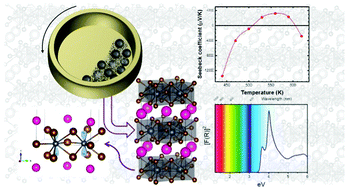The structural evolution, optical gap, and thermoelectric properties of the RbPb2Br5 layered halide, prepared by mechanochemistry†
Abstract
Rubidium di-lead pentabromide, RbPb2Br5, belongs to a family of layered lead-containing halides, with the common formula APb2X5 (where A = K, Rb, Cs; X = Cl, Br). The optical properties of RbPb2Br5 and rare-earth doped specimens are promising as low-phonon energy materials for tunable middle infrared and long-wavelength infrared laser sources, with suitable stability and resistance to wet conditions. In contrast to CsPb2Br5, the Rb counterpart has been barely studied and deserves further attention. Up to now, there have been no experimental reports on the transport properties such as the electronic conductivity, Seebeck coefficient or thermal transport. We describe here that this material can be prepared by ball milling in a straightforward way, yielding specimens with superior crystallinity. A structural investigation using synchrotron X-ray powder diffraction (SXRD) data combined with neutron powder diffraction (NPD) in a wide temperature range, from 15 to 573 K, was essential to evaluate the thermal evolution and to determine the Debye constants, yielding information on the relative Rb–Br and Pb–Br chemical bonds. In combination with DSC and TG measurements, no phase transitions were observed. Furthermore, an analysis of SXRD and NPD data (XRD-NPD) at room temperature reveals the directions of electron lone pair of Pb2+ ions lead atoms: its stereochemical effect is obvious in the [PbBr8] octahedral distortions. Diffuse reflectance UV-Vis spectroscopy yields an optical gap of 3.36 eV, close to that determined for a single-crystal material. Photoluminescence measurements indicate a lack of overlap between the excitation and emission spectra, due to the considerable Stokes shift, which prohibits self-absorption and thus enables applications in photovoltaics and biomedicine. The experimental information about the chemical bonds and band gap was studied via first-principles calculations. A maximum positive Seebeck coefficient of 3 200 μV K−1 is obtained at 560 K, which is one order of magnitude higher than those reported for other halide perovskites.



 Please wait while we load your content...
Please wait while we load your content...